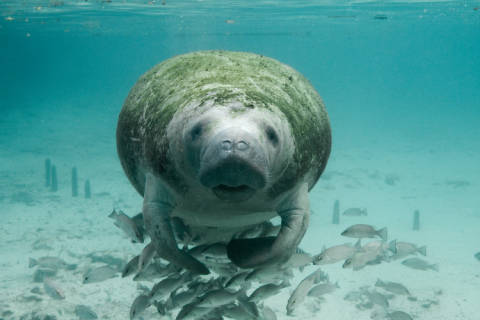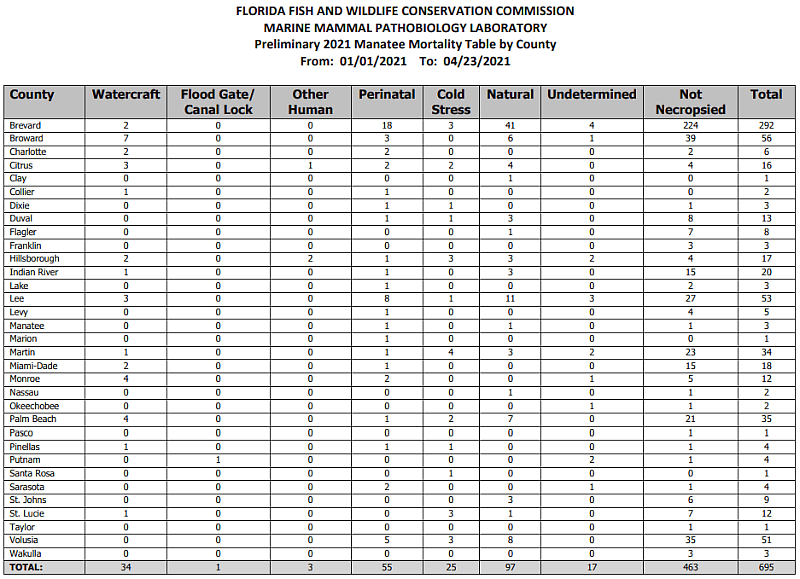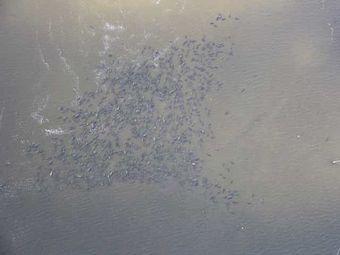IRLNews:2021-04-01/Indian River Lagoon Manatee Mortality Update
The Indian River Lagoon National Estuary watershed has reported 444 manatee deaths in 2021.[3] 11% of Florida's estimated east coast manatee population has expired in the IRL this winter.
| County | 2/26/2021 | 3/26/2021 | 4/23/2021 |
|---|---|---|---|
| Volusia | 16 | 26 | 51 |
| Brevard | 168 | 248 | 292 |
| Indian River | 13 | 21 | 20 |
| St. Lucie | 4 | 11 | 12 |
| Martin | 24 | 31 | 34 |
| Palm Beach | 29 | 34 | 35 |
| Total | 254 | 371 | 444 |
Brevard County Manatee Mortality
Brevard County's 292 manatee mortalities, 7% of the estimated east coast population, have met the criteria to be declared an Unusual Mortality Event (UME) by the Working Group on Marine Mammal Unusual Mortality Events. The 2021 Florida Atlantic Coast Manatee UME is the 71st declared under the Marine Mammal Protection Act since 1991.[4]
There are many factors affecting Brevard's manatee population. All due to human impact.
Natural Migration Interruption
During the winter manatees congregate in the Port St. Johns compartment of the North Indian River Lagoon due to the warm water discharge from the power plant. Manatees would normally migrate south as the water temperature drops, but the power plant's warm water outflow distracts them from their natural migration. While the resident manatee population is estimated at 500 individuals, a 2016 aerial survey counted 1,400 winter manatees in the PSJ compartment of the North IRL. An estimated 35% of Florida's east coast manatee population moves into the power plant heated Port Saint John compartment of the Indian River Lagoon during the winter months.
Loss of Seagrass
It is estimated that the Indian River Lagoon has lost 54% of the record high seagrass coverage recorded in 2007.[5]
Manatees may eat up to 10% of their body weight daily. For example, lets assume that 1400 manatees with a average weight of 500lbs might consume seagrass at the rate of 70,000lbs daily or 6.3m lbs during a 90 day winter. Even with perfect water quality the PSJ compartment of the North IRL could not possibly produce enough seagrass to support the huge visiting manatee population attracted to the power plant's warm discharge.
Water Quality in the PSJ Compartment
The Port Saint John compartment has no inflows other than nutrient laden stormwater run-off. The exchange of water with other IRL compartments is impeded on the north by SR405 NASA Causeway (82% constriction), and SR528 Merritt Island Causeway (73% constriction) to the south. Hard embankments on the west shore and mosquito impoundments on the east eliminate 100% of the lagoon's natural filtering systems.
The lack of water exchange causes an estimated 220 day residence time in the PSJ compartment. What goes into it's water may remain for 7 - 8 months. As much as 700m gallons of the compartment's impounded, nutrient rich water is circulated through the plant's cooling system daily.[6]
Considering that the visiting manatee herd might excrete half of the seagrass it eats, amounts to 35,000lbs per day, or 3.15m lbs per winter, added to the PSJ compartment's excessive nutrient load.
Conclusion
Florida has reached the point where power utilities have to provide temporary pumps and heaters to continue the manatee's dependence on power plant outflows. If a plant is decommissioned, the power company must continue providing heated water to it's dependent manatees indefinitely. If a plant shuts down unexpectedly and the heated discharge stops, the visiting manatee population may suddenly expire due to cold exposure.
The obvious solution to Brevard's winter manatee problem is to slowly eliminate the heated discharge. Power companies must reduce thermal pollution in the Indian River Lagoon in order to eliminate the manatee's dependence on power plant discharges.
The good news is that spring is here, the lagoon's water temperature has warmed up, and Brevard's wintering manatees are headed home until next year.
Video
Video courtesy of Brevard Indian River Lagoon Coalition
Web Links
- Bloomberg Businessweek: Nobody Knows How to Wean Manatees Off of Power Plants
- FPL customers pay to keep manatees cozy and alive - Orlando Sentinel
- FWC - Summary of Warm Water Refugia Issues
- FWC: Manatee Mortality Event Along The East Coast: 2020-2021
- NOAA Marine Mammal Unusual Mortality Events
- Winter Manatee Foraging Behavior and the Decline of Seagrass Beds in the Northern Indian River Lagoon USGS 2015
- FWC Update to the Statewide Florida Manatee Abundance Estimate
Documents
- FWC 2021 Preliminary Manatee Mortality Table (PDF 19pp 562KB)
- FWC 2021 YTD Manatee Mortality Table (PDF 1p 113KB)
- Updated Statewide Abundance Estimates for the Florida Manatee (PDF 27pp)
References
- ↑ Updated Statewide Abundance Estimates for the Florida Manatee (PDF 27pp), ISSN 1930-1448, page 5, retrieved 2021-04-01.
- ↑ FWC 2021 Preliminary Manatee Mortality Table (PDF 22pp 562KB), retrieved on 2021-04-28.
- ↑ FWC 2021 YTD Manatee Mortality Table (PDF 1p 113KB), retrieved 2021-04-23
- ↑ NOAA Marine Mammal Unusual Mortality Events, retrieved 2021-04-28.
- ↑ Dr. Chuck Jacoby, SJRWMD, 2020 Water Quality Presentation Video, retrieved: October 11, 2020
- ↑ FPL customers pay to keep manatees cozy and alive - Orlando Sentinel, published 2010-12-05, retrieved 2021-04-01.





